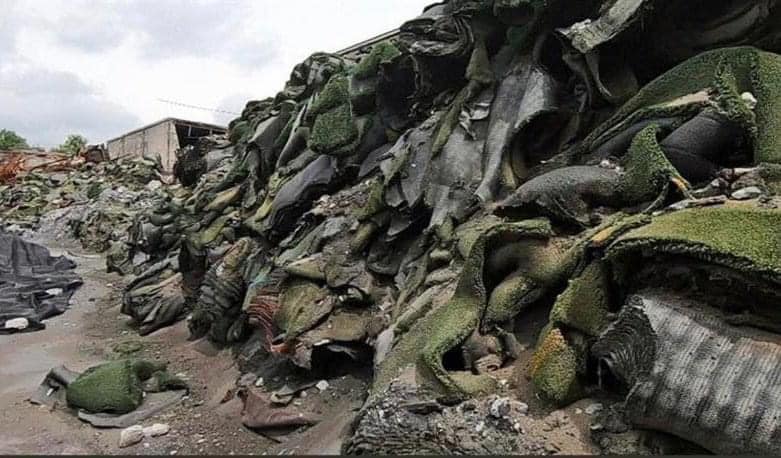The biodiversity on our planet is facing an unprecedented threat. In the last 50 years wildlife populations have declined by over two thirds (69%) including mammals, birds, fish, amphibians, reptiles, and insects in countries all over the world. Among these the UK is one of the most depleted countries in Europe in terms of nature. The primary reason for this rapid depletion is the loss of natural habitats caused by the deterioration of our gardens and green spaces, as well as the disappearance of "green corridors" in our cities.
In recent years, the widespread use of plastic grass and plants has greatly exacerbated this problem causing devastating effects on both the environment and biodiversity. As part of their commitment to sustainable landscape and garden design the Society of Garden Designers is campaigning to raise awareness of the extreme environmental damage caused by these products.

WHY IS PLASTIC GRASS HARMFUL TO BIODIVERSITY AND THE ENVIRONMENT?
Plastic grass and plants are harmful to both biodiversity and the environment for several reasons.
1. Firstly, they destroy natural habitats and soil. The installation of plastic lawns involves digging out the topsoil, which takes 2000 years to form just 100mm of it. The remaining soil is then suffocated by the layer of plastic killing earthworms, natural organisms and fungi that thrive in the soil. This eliminates plants and all sources of food and habitat for insects, birds, and animals.
2. Secondly, plastic grass and plants contribute to carbon emissions. They are made from fossil fuel-based plastics whose extraction and processing are a net producer of CO2. Shipping them from overseas manufacturers also produces carbon emissions which contribute to global warming through the emission of greenhouse gases. On the other hand, real grass lawns process and absorb CO2 which makes them beneficial to the environment.
3. Thirdly, plastic grass and plants contribute to urban heat islands. When exposed to the sun, real lawns cool themselves naturally through evaporation. In contrast, plastic lawns absorb the heat, creating heat "islands" that can be up to 26°C hotter than the surrounding air. This is also bad for children and pets to play on as it can burn their skin.
4. Fourthly, plastic grass and plants cause flooding. Natural lawns absorb almost every drop of rain helping to slow the flow of water into drains. However, plastic grass absorbs less than 50% causing run-off and in turn flooding.
5. Finally, plastic grass and plants pollute our waterways. Over time, the plastic used to make artificial grass and plants breaks down and is washed into our drainage system, discharging microplastics into our rivers and seas. Cancer is on the rise!

THE FACTS ABOUT PLASTIC GRASS AND PLANTS
-
They are non-biodegradable Artificial plants and grass are composed of non-biodegradable plastics like polypropylene, polyurethane, and polyethylene. None of these materials can decompose naturally.
-
They cannot be recycled Recycling plastic plants and grass is impossible, even for products that claim to be recyclable. As of now, there are no appropriate recycling facilities in the UK for these materials.
-
They have a limited lifespan Plastic grass has an approximate lifespan of 15 years. After that, it is sent to landfills where it continues to pollute the environment.
-
They require maintenance Over time plastic grass accumulates waste and organic material from animals and plants. This means regular cleaning with disinfectants and other chemicals.
WHAT ARE THE ALTERNATIVES TO PLASTIC GRASS
Grass Lawns
Grass lawns are sustainable, environmentally friendly and safe for animals and children to play on. They also have a natural resistance to drought so if you are worried about the amount of water needed to keep them alive, don’t be! As a species, grass is one of the toughest plants on the planet and will recover as soon as it rains. You can have a beautiful striped lawn and look after it in a sustainable way. There is no need to use chemicals now we have an interchangeable cartridge system for scarification and aeration etc. You can also surround your lawn with flower beds to attract the bees!
Drought Tolerant Lawn
Drought-tolerant lawns can offer a sustainable solution to water conservation.These will play a big part in our future as the temperature increases and we will see the UK switching to the grass types seen in hotter countries. Clover lawns are an excellent option as they require minimal maintenance, no mowing or watering, and will stay green year-round. In the summer, they bloom with a stunning array of flowers, attracting pollinators and wildlife. Additionally, clover is a legume, which means it absorbs nitrogen from the air and enriches the soil naturally, providing fertiliser for itself and neighbouring plants. Clover lawns are also resilient and can be stepped on without causing any damage.
Kids / dogs lawn
When it comes to play areas natural lawns are still one of the best choices. They can be maintained in the autumn and re-seeded as needed. Natural lawns not only provide a great surface for ball games but also allow children to come into contact with soil and immune-boosting microbes offering a nature-based play experience that is good for their health and well-being. In contrast, ongoing research suggests that plastic lawns cause higher rates of injury than natural grass and release toxic gases into the air that can be inhaled.

